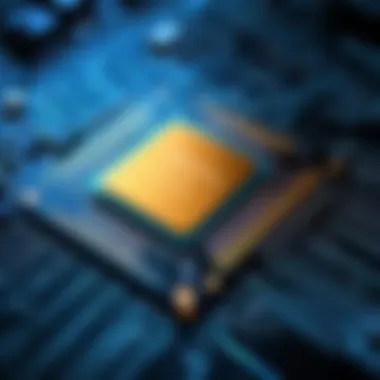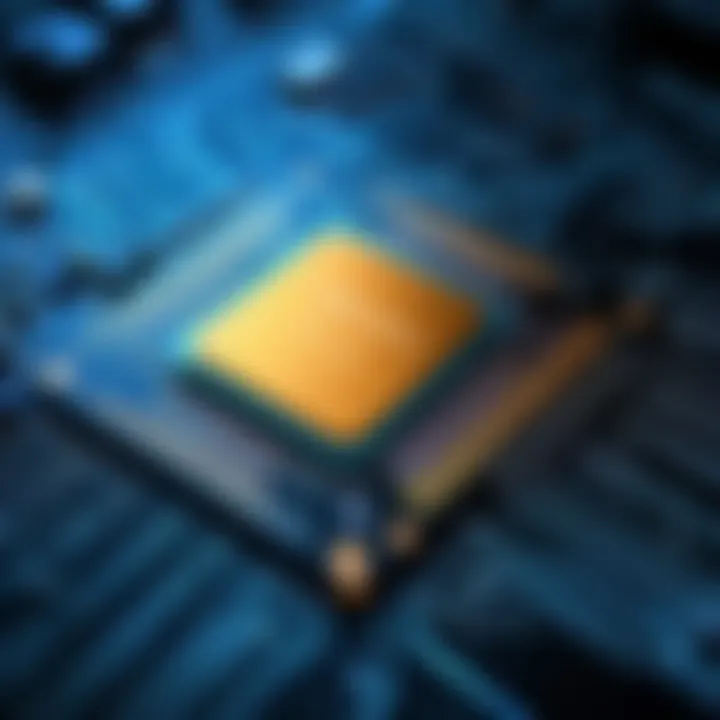Understanding Computer Processors: Architecture & Performance


Intro
Understanding the essence of a computer processor is vital for anyone engaged in the world of technology. As the brain of a computer, the processor executes instructions, processes information, and ultimately shapes user experiences. This article takes a closer look at computer processors, exploring their functionalities, architectural differences, and evolution over time. We aim to equip professionals, entrepreneurs, and tech enthusiasts with the knowledge needed to comprehend the intricate workings of processors.
Technological Research Overview
In the constant landscape of technology, processors have adapted and evolved. Numerous research initiatives focus on assessing and enhancing processor performance. Understanding these trends is essential for advancing technology applications.
Recent Technological Innovations
Recent advancements such as Alienware x17 R2, lining a path towards improving computing capabilities are noteworthy. Innovations like 12th Generation Intel Core Processors have showcased enhanced multi-threading capabilities and increased power efficiency. This focus on parallel processing allows tasks to be completed at faster rates. Additionally, technologies involved in semiconductor manufacturing continue to push the limits of performance.
Impact on Business Operations
The choice of processors can directly influence a business’s operational efficiency. High-performance processors ensure that applications run smoothly, allowing for effective multitasking. Businesses that remain aware of the latest processor developments can better harness innovations for operational excellence. Companies that integrated AMD Ryzen 9 processors have detailed increased speeds which enhance cloud computing capabilities crucial for remote operations.
Future Technological Trends
Looking ahead, trends suggest that quantum processors may revolutionize computing. Research into quantum computing aims at resolving problems that traditional processors cannot handle efficiently. Fascination with developments regarding modulators and quantum bits highlights potential pathways toward new business solutions.
“The shift towards quantum processing showcases the frontiers of technology, challenging existing paradigms.”
Additional focus on more energy-efficient processors corresponds with rising environmental awareness. Designs that utilize less power while maintaining superior performance will likely emerge.
Data Analytics in Business
As organizations today increasingly rely on data-driven insights, the role of processors becomes more prominent. Consequently, understanding the impact of processors on data analytics is crucial.
Importance of Data Analytics
Data analytics drives decision-making in businesses today. Companies need cores that stand up to massive data processing demands. Efficient data analytics heavily relies on multi-core processors to break down workloads into manageable tasks more efficiently.
Tools for Data Analysis
To manage and analyze data effectively, various tools and platforms are available. Softwares such as Tableau and R leverage potent processors for aggregating and analyzing large datasets, which allows firms to derive deeper insights every day. Choosing optimal processing power translates directly to quicker analysis times and more effective strategies.
Case Studies on Data-Driven Decisions
Several companies have successfully harnessed processors coupled with data analytics for impactful decision-making. For example:
- Consol Energy accelerated decision-making by adopting innovative data analytics software and corresponding processor upgrades, enabling real-time data analysis.
- Amazon utilized enhanced multi-threading processors to streamline their logistics and supply options, adapting rapidly to consumer needs.
Cybersecurity Insights
As the relevance of processors in bolstering cybersecurity continues to grow, understanding their implications is necessary to guard digital resources effectively.
Threat Landscape Analysis
The current landscape of cybersecurity threats remains vast and evolving. High-performance processors facilitate more in-depth threat analysis and quicker reaction capabilities which are essential.
Best Practices for Cybersecurity
Maintaining robust defenses against attacks requires modern processors to support strong security applications. Inclusion of secure enclaves in processors enables isolation of sensitive tasks, minimizing vulnerabilities against cybersecurity threats such as malware and exceed confidentiality.
Regulatory Compliance in Cybersecurity
Keeping up with regulations requires businesses to invest in powerful processors that facilitate compliance with standards, ensuring minimum risk exposure.
Artificial Intelligence Applications
Adoption of artificial intelligence has significant implications on how processors are utilized in technology landscapes.
AI in Business Automation
AI applications demand high processing capabilities in order to evaluate and learn from vast datasets to ensure automation proceeds smoothly. Complex algorithms benefitting from multi-core arrangements speed operations and improve decision-making at various levels.


AI Algorithms and Applications
Different AI models require elaborate computations. Processors designed with tensor processing units can manage this computation efficiently, leading to spectacular functionality of applications varying from face recognition to personalized recommendations.
Ethical Considerations in AI
As our reliance on AI grows, it prompts a discussion around ethics in adopting AI solutions, particularly with processing power enabling decisions that affect human lives. Industry conversations must eventually address ethical concerns to progress effectively.
Industry-Specific Research
Understanding how processors mesh with industry needs is essential for technological advancement.
Tech Research in Finance Sector
Within finance, speed and performance are critical. Banks utilizing FPUs focus on high-efficiency processors to enhance transaction processing and security analysis.
Healthcare Technological Advancements
In healthcare, powerful processors can assist with imaging and data analysis, fostering quicker, more precise diagnostic tools that benefit patient care. Enhanced processing power has enabled more intricate simulations that result in better patient outcomes.
Retail Industry Tech Solutions
In the retail sector, the ongoing development of cashier-less checkouts using advanced processors improves customer experience and augments commerce efficiency. More responsive processors streamline operations with data-driven analytics becoming more prevalent.
As technology continues to evolve, understanding the importance of computer processors becomes vital. This knowledge empowers professionals to make informed choices in their technology adoptions.
Understanding the Computer Processor
Computer processors, also known as central processing units (CPUs), serve as the heart of modern computing systems. Understanding their fundamental roles and significance is crucial for both tech professionals and enthusiasts. This section provides an overview of what processors do and why they matter in the broader landscape of computing.
Definition and Fundamental Roles
A computer processor is an integrated circuit that executes instructions, performs calculations, and controls other components of a computer system. More specifically, it interprets and executes instructions made up of binary data — zeroes and ones. These fundamental roles can be defined in a few key components:
- Execution of Instructions: Processors perform the tasks specified by software programs, from simple calculations to complex algorithms.
- Control Unit and Arithmetic Logic Unit: The control unit directs the operation of the processor, while the arithmetic logic unit handles all mathematical and logical operations.
- Interaction With Other Components: Processors communicate with various hardware components like RAM and storage, enabling them to function coherently in a system.
The need for understanding these aspects grows as systems become more complex. Each evolution of processor design introduces enhancements and different architectures aiming to cater better to varying computing demands.
The Central Role in Computing Systems
The central role of processors goes beyond mere data handling; they are indeed the brains of computing systems. Their efficiency directly impacts the performance and functionality of devices. Here are a few essential points to comprehend this pivotal role:
- Performance Influencer: A processor’s capability defines the speed and power of a computing system. A faster processor improves task completion time and overall efficiency.
- Parallel Processing: Modern processors often include multiple cores, facilitating simultaneous processing of multiple instructions. This allows for efficiency in multitasking environments, where different applications vie for computing resources.
- Adaptability: As technology advances, processors continuously adapt. Emerging trends such as artificial intelligence and big data analytics substantially call for enhanced processing strengths. Developers design specialized processors to meet these obligations efficiently.
The advancement of processor technology is vital for modern computing, driving growth across multiple industries.
Understanding these roles enables users and decision-makers to analyze system needs better and meticulously choose the right processors, thus optimizing performance for specific applications. Overall, a sound understanding of what a computer processor is and the roles it plays lays the groundwork for deeper exploration throughout this article.
Historical Evolution of Processors
The historical evolution of processors is crucial in understanding the development and capabilities of modern computers. Beginning from rudimentary systems, the progress of processor technology reflects exponential growth in computing power and efficiency. Each stage of this evolution offers insights into the design philosophy and engineering challenges faced by developers, ultimately shaping the computer systems we employ today.
Early Innovations in Processor Design
In the 1960s, the field of computing experienced substantial innovations in processor design. Early devices like the IBM 7094 and the DEC PDP-8 laid the groundwork for subsequent development. Most importantly, these early processors employed architecture that prioritized versatility and efficiency, albeit at low speeds by today’s standards. Their design incorporated several functional units for processing instructions, which opened up new possibilities for programming and computing tasks.
The introduction of integrated circuits marked a pivotal moment in processor history. Unlike discrete transistors, integrated circuits allowed for the incorporation of multiple transistors on a single chip, thus vastly improving the processing capacity and reducing physical size. This innovation led to the creation of the first microprocessors in the early 1970s, which dramatically shifted the landscape of computing.
"The invention of the microprocessor signaled a shift from larger, cumbersome computers to personal computing."
The Transition to Microprocessors
The transition to microprocessors began with Intel’s 4004 in 1971, one of the first commercially available microprocessors. This marked a significant step toward the development of compact, powerful computing devices. Microprocessors could handle multiple operations simultaneously, lending themselves to various applications in homes, businesses, and industries.
With the introduction of this architecture, various manufacturers, including AMD and Motorola, entered the market. This competition spurred continuous improvement in processing power. Microprocessors offered higher clock speeds, increased memory capabilities, and enhanced performance per watt of power consumed. Today’s processors can manage complex computations at speeds that early innovators could not even imagine.


The significance of microprocessors cannot be understated: they formed the cornerstone of devices ranging from computers to mobile phones, revolutionizing how we interact with technology. As we track advancements in processor technology, it becomes evident that each innovation builds on foundational principles established in earlier designs, paving the way for today's exceptional architectures.
Types of Computer Processors
Understanding the various types of computer processors is vital in comprehending how computational tasks are executed efficiently. Each processor type, optimized for different applications, has its own significance. From managing simple tasks to handling complex computations in gaming or AI, processors play a crucial role in defining overall system performance.
Single-Core vs.
Multi-Core Processors
Single-core processors were once the standard, wherein the CPU could only manage one stream of instructions at any given time. These processors perform tasks sequentially, which limits their capability in handling multitasking abilities effectively. When the sole core is engaged with a task, chances of lagging are prominent with additional demands.
Conversely, multi-core processors, which integrate multiple cores onto a single chip, facilitate enhanced parallel processing. Each core can handle different instructions simultaneously. This results in improved performance when engaging with multi-threaded applications. Programming that leverages these cores yields expedient results. For users focused on tasks such as video editing or gaming, multi-core processors are increasingly becoming the necessary choice. Thus, understanding how many cores are required becomes vital when choosing a CPU, tailored for specific task demands.
Embedded Processors
Embedded processors are designed for special system implementations within a larger system. They are common in devices like washing machines, microwave ovens, and automotive systems, serving specific functions dedicatedly. Embedding specialized microcontrollers or DSPs means that performance is enhanced in operations tailored for those devices. *
One advantage of these processors lies in their adequate power efficiency compared to traditional processors. Because they run streamlined tasks, they often have lower heat output, conserving energy and preserving lifespan. It's essential to ensure that suitability to the application's requirements and hardware environment is considered for making the most effective choices.
Specialized Processors: GPUs and FPGAs
Specialized processors focus on executing stringent computations efficiently and often handle repetitive but large datasets. The Graphics Processing Unit (GPU) and Field-Programmable Gate Array (FPGA) are key examples. While GPUs excel in rendering complex graphics by handling thousands of simultaneous operations, FPGAs offer programmability, allowing them to adapt to diverse processing needs are common in sectors requiring rapid prototyping or iterative designs.
Here are some distinct characteristics to note:
- GPU:
- FPGA:
- Parallel processing ability enriches multimedia content tasks.
- Widely used in gaming and graphics fields due to frame-rate optimization.
- Custom configuration can cater to various specific applications.
- Excellent for testing theories or operational schemes in scientific settings.
Utilizing these specialized processors leads to enhanced performance and efficiency in niche applications. Holistically, understanding these differences ensures that optimal decisions regarding hardware are made and fosters overall operational effectiveness in technological environments.
This comprehension will lead towards a better selection of your future computing resources.
Processor Architecture
Processor architecture plays a crucial role in defining how a computer processes information. It encompasses the fundamental design principles and operational functionalities of the processor. Understanding processor architecture is essential because it directly affects computing performance, efficiency, and capability to support complex tasks. At its core, this concept focuses on how the components of a processor work together and the methodologies used for data handling, which in turn influences system performance.
The design of a processor accommodates both its hardware and the software that runs on it. Solid architecture lays the framework for executing instructions and managing resources, impacting everything from speed to power consumption. Several factors must be considered when examining processor architecture, including.
- Instruction Set Architecture (ISA): Determines the set of commands the processor can understand and execute.
- Data Flow Architecture: Affects how data moves within the processor and between different components.
- Control Flow: Refers to the methodological way of managing the execution of instructions.
These factors inform decisions around chip design and usability, presenting varying advancements like multiprocessing, which utilizes cores effectively for task performance, and reduced instruction sets that enhance processing speed, while promoting efficiency.
Von Neumann Architecture
Von Neumann architecture represents a traditional model for computer architecture. Proposed by John von Neumann in the 1940s, this architecture introduced a computing framework that specifies how a computer should be organized and operate. Essentially, it combines both data and program within a single memory space. This integration simplifies the design—programs and data coexist in the same memory, allowing for greater efficiency in certain programming environments.
Key aspects of Von Neumann architecture include:
- Memory Storage: There is a unique storage area for both instructions and data.
- Single Processing Unit: Instructions are processed sequentially due to the unified throughput, creating a bottleneck known as the 'Von Neumann bottleneck.' This bottleneck restricts processing speed because the CPU must handle both data and instructions at the same time.
- Flexibility: Programs can be easily modified, as they are treated as mutable data.
The highlights of Von Neumann architecture have set the foundation for much of modern computing, even as potential performance impacts encourage exploration of alternative architectures.
Harvard Architecture
Harvard architecture arises as a counterpoint to Von Neumann architecture. Developed around the same time, it presents a more compartmentalized approach to processor design. In this architecture, a separate memory storage for instructions and data is present. Essentially, it permits simultaneous data loving and instruction processing, thus reduces data traffic and boosts execution speed in many scenarios.
Essential elements of Harvard architecture include:
- Dual Memory Systems: Separate memory pools help sidestep the bottleneck prevalent in a unified architecture.
- Enhanced Throughput: Concurrent access to instructions and data speeds up processing, making it suitable for specific tasks such as digital signal processing.
- Complexity in Design: While effective, designing a Harvard architecture can be more intricate, with increased chip costs and resource demands, which may limit flexibility in some use cases.
Both Von Neumann and Harvard architectures showcase the continuum of computer processor design. Each architecture serves distinct processing needs, indicating a diverse range of applications tailored to efficiencies respective of architecture types.


Key Performance Metrics
Key performance metrics are essential for understanding how effectively a computer processor functions. These metrics not only influence overall performance but can also guide engineers and consumers in choosing the right processor for specific requirements. Three major metrics come to mind: clock speed, cache memory, and thermal design power (TDP). Each plays a role in assessing a processor’s capabilities.
Clock Speed: Its Importance and Limitations
Clock speed, measured in gigahertz (GHz), indicates how many cycles a processor can perform in one second. It is often seen as a primary indicator of performance. However, it is crucial to understand that higher clock speeds do not always mean better performance. The architecture of the processor and the type of tasks it executes are significant factors.
The speed at which a processor operates can greatly influence the speed of data processing and the execution of applications. For example:
- In single-threaded applications, higher clock speeds can lead to faster response times.
- In multi-threaded environments, other metrics such as the number of cores may play a more substantive role.
A limitation of clock speed is the potential for overheating. Every processor has a defined limit for its clock speed, beyond which it could consume excessive power and generate heat that might harm its components.
Cache Memory: Understanding Levels and Impact
Cache memory acts as a high-speed storage area between the processor and the main memory (RAM). Processors often have multiple levels of cache, commonly referred to as L1, L2, and L3. This hierarchy is critical for performance because it enhances data retrieval speeds that directly affect processing time.
- L1 Cache: Lengthy access time and small size mutate rapid data access to specific instructions.
- L2 Cache: A larger size than L1 but with a bit slower access time, fortifies the speed difference.
- L3 Cache: Acts as a larger buffer, accessible to multiple cores and sharing data effectively, yet has the slowest speed among the three.
Overall, the presence and size of cache memory immensely impact the effective running of applications and computational tasks. Efficient cache utilization can dramatically boost performance, particularly for tasks requiring rapid data access.
Thermal Design Power (TDP)
Thermal design power (TDP) is a crucial metric that denotes the maximum amount of heat a processor can generate when operating at full capacity. Manufacturers specify TDP to guide system designers in selecting adequate cooling solutions for processors.
Understanding TDP is important for several reasons:
- It helps in evaluating the energy efficiency of a processor. More efficient processors generate less heat, which typically contributes to longer longevity and reliability.
- High TDP values may require heavy-duty cooling solutions, which can affect the overall design and budgeting of a computing system.
- TDP has a relationship with overall performance since higher performance chips, traditionally, consume more power.
To summarize, awareness of key performance metrics not only facilitates informed hardware decisions but ensures that the selected processors align with specific applications and workloads.
The Role of Technology Advancements
Technology advancements play a crucial role in shaping computer processors. Their development not only enhances processing power but also improves energy efficiency and functionality. Continuous improvements in technologies serve as the backbone for modern computing, paving the way for innovative applications and solutions.
The Impact of Semiconductor Technology
Semiconductor technology is foundational to the production and operation of computer processors. This category refers to materials that possess conductive properties capable of conducting electricity under specific conditions. The microprocessors that are in widespread use today rely heavily on semiconductor components.
Key Developments in Semiconductor Technology:
- Miniaturization: The trend towards smaller processing chips has allowed manufacturers to pack more transistors into compact spaces. This aspect dramatically increases processing capability and performance while reducing electrical leakage and energy consumption.
- Multiple Semiconductor Materials: The exploration of materials such as gallium nitride and silicon carbide indicates a shift in focus towards speed and efficiency. These materials exceed the performance limits of traditional silicon in many applications.
- Production Techniques: Advances in fabrication processes such as photolithography and etching have led to more complex processor designs. These refinements significantly enhance the function and capabilities of modern processors.
"The development of semiconductor technology defines the threshold of what is possible in processor design, offering transformers for future advancements."
Through these advancements, semiconductor technology enables processors to become smarter and more powerful, capable of handling complex tasks faster than before. The increasing demands for better performance sync well with sustained progression in this field, which continues to create dynamic opportunities in computing.
Quantum Computing and Processors
Quantum computing represents a paradigm shift in the landscape of computing technology. Unlike traditional methods which rely on bits [0s and 1s], quantum computing utilizes qubits. This initially complicated method opens the door for unparalleled processing power and efficiency.
Importance of Quantum Computational Development:
- Parallelism: Quantum processors allow for numerous calculations to occur simultaneously. This characteristic vastly cuts computation time and expedites problem-solving.
- Complex Problem Solving: Quantum processors hold great potential for tackling intractable problems in cryptography, pharmaceuticals, and materials science—areas that conventional computers struggle with, even the most powerful supercomputers.
- Cheers of Acceleration: The future of computing relies significantly on microprocessor design that aligns well with quantum technology's capabilities, including stability, error correction, and cooling solutions.
Quantum computing continues to evolve, revealing both exciting prospects and technical challenges that require deep understanding. It necessitates a deeper dive into algorithms and models catering to this technology, which will, in turn, inform the future directions of processor development.
In summary, understanding the influence of technology advancements on processors is essential. Whether it is through refined semiconductor materials or the forward-thinking realm of quantum computing, these elements underscore the milestone transitions that will further develop the comprehensions and applications of computer processors.
Culmination
In concluding this comprehensive exploration of computer processors, it is essential to recognize the significance of understanding their evolution, types, architectures, and performance metrics. Knowledge of processors extends far beyond the realm of basic computing; it shapes how professionals and tech enthusiasts embrace emerging technologies and anticipate their impacts on society.
Future Trends in Processor Development
As we look ahead, several future trends in processor development warrant attention. The advancement in semiconductor technology, for instance, continues to push the boundaries of what processors can achieve. By utilizing smaller transistors, manufacturers can enhance the processing power while reducing energy consumption, a trend observed in processors from companies like Intel and AMD. Moreover, with the rise of quantum computing, the landscape of processing capability may fundamentally change. Quantum processors harness the principles of quantum mechanics for unprecedented calculations, promoting rapid advances in areas like cryptography, drug discovery, and artificial intelligence.
Going beyond just hardware developments, the software side is also evolving. New programming paradigms will be required to exploit these powerful processors. It's fundamental that both software engineers and hardware manufacturers collaborate to innovate solutions that optimize processor functionality.
Furthermore, artificial intelligence integration into processors is becoming more prevalent. With dedicated AI accelerators, CPUs and GPUs work harmoniously to process tasks more efficiently. This integration might revolutionize industries by vastly improving computing efficiency and performance.
In sum, the future of processor development is filled with significant potential and innovation. By staying informed and adapting to these advancements, professionals can harness the full spectrum of processing power and apply it practically in their respective, influential fields.







